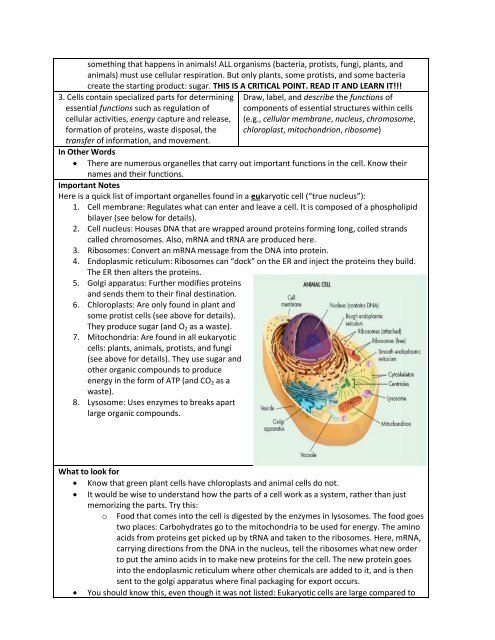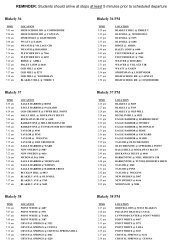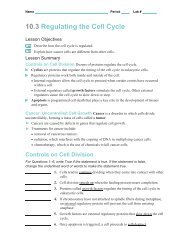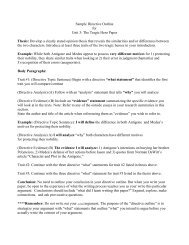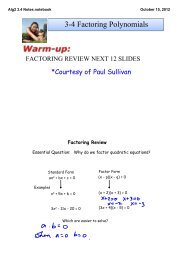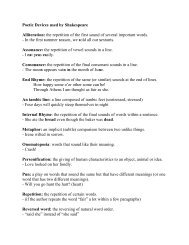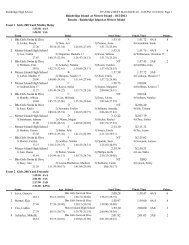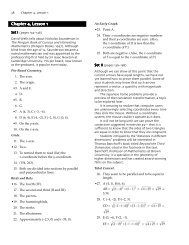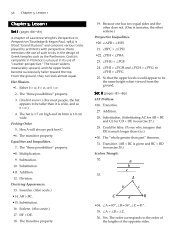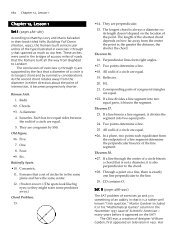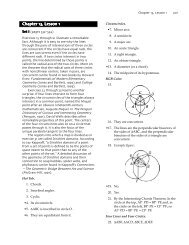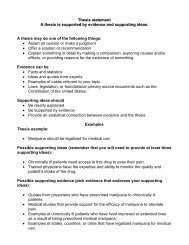Biology EOC Study Guide: Part 2, Cell Biology Content Standards ...
Biology EOC Study Guide: Part 2, Cell Biology Content Standards ...
Biology EOC Study Guide: Part 2, Cell Biology Content Standards ...
You also want an ePaper? Increase the reach of your titles
YUMPU automatically turns print PDFs into web optimized ePapers that Google loves.
something that happens in animals! ALL organisms (bacteria, protists, fungi, plants, and<br />
animals) must use cellular respiration. But only plants, some protists, and some bacteria<br />
create the starting product: sugar. THIS IS A CRITICAL POINT. READ IT AND LEARN IT!!!<br />
3. <strong>Cell</strong>s contain specialized parts for determining<br />
essential functions such as regulation of<br />
cellular activities, energy capture and release,<br />
formation of proteins, waste disposal, the<br />
transfer of information, and movement.<br />
In Other Words<br />
<br />
Draw, label, and describe the functions of<br />
components of essential structures within cells<br />
(e.g., cellular membrane, nucleus, chromosome,<br />
chloroplast, mitochondrion, ribosome)<br />
There are numerous organelles that carry out important functions in the cell. Know their<br />
names and their functions.<br />
Important Notes<br />
Here is a quick list of important organelles found in a eukaryotic cell (“true nucleus”):<br />
1. <strong>Cell</strong> membrane: Regulates what can enter and leave a cell. It is composed of a phospholipid<br />
bilayer (see below for details).<br />
2. <strong>Cell</strong> nucleus: Houses DNA that are wrapped around proteins forming long, coiled strands<br />
called chromosomes. Also, mRNA and tRNA are produced here.<br />
3. Ribosomes: Convert an mRNA message from the DNA into protein.<br />
4. Endoplasmic reticulum: Ribosomes can “dock” on the ER and inject the proteins they build.<br />
The ER then alters the proteins.<br />
5. Golgi apparatus: Further modifies proteins<br />
and sends them to their final destination.<br />
6. Chloroplasts: Are only found in plant and<br />
some protist cells (see above for details).<br />
They produce sugar (and O 2 as a waste).<br />
7. Mitochondria: Are found in all eukaryotic<br />
cells: plants, animals, protists, and fungi<br />
(see above for details). They use sugar and<br />
other organic compounds to produce<br />
energy in the form of ATP (and CO 2 as a<br />
waste).<br />
8. Lysosome: Uses enzymes to breaks apart<br />
large organic compounds.<br />
What to look for<br />
Know that green plant cells have chloroplasts and animal cells do not.<br />
It would be wise to understand how the parts of a cell work as a system, rather than just<br />
memorizing the parts. Try this:<br />
o Food that comes into the cell is digested by the enzymes in lysosomes. The food goes<br />
two places: Carbohydrates go to the mitochondria to be used for energy. The amino<br />
acids from proteins get picked up by tRNA and taken to the ribosomes. Here, mRNA,<br />
carrying directions from the DNA in the nucleus, tell the ribosomes what new order<br />
to put the amino acids in to make new proteins for the cell. The new protein goes<br />
into the endoplasmic reticulum where other chemicals are added to it, and is then<br />
sent to the golgi apparatus where final packaging for export occurs.<br />
You should know this, even though it was not listed: Eukaryotic cells are large compared to


